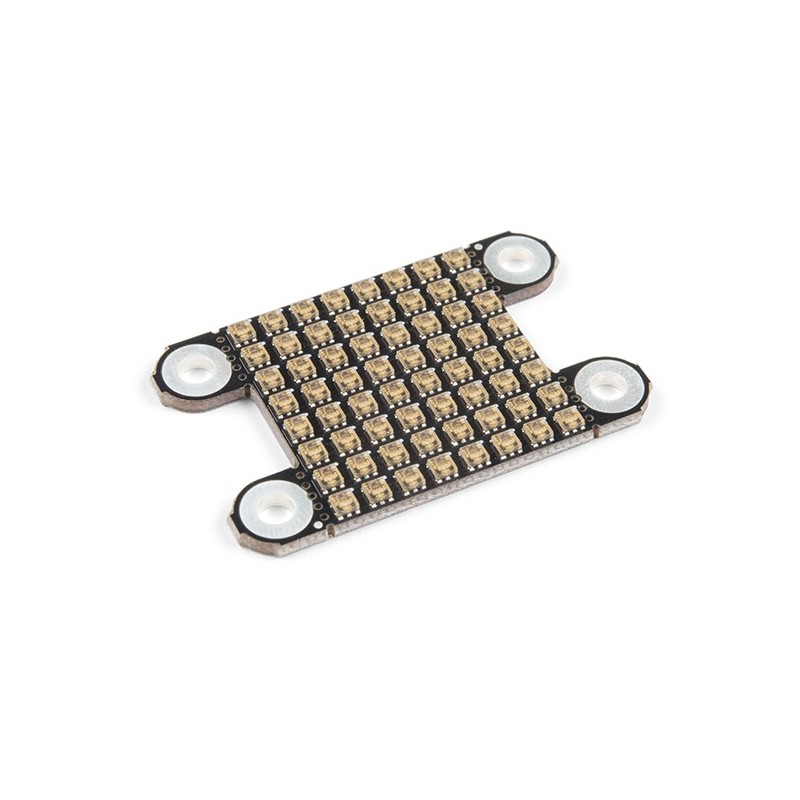





RGB LED matrix module with 64 APA102-2020 diodes in 8x8 arrangement. It is powered by 5 V by the pads located on the bottom of the board and controlled by the SPI interface. The matrix functions like a string of LEDs and the numbering moves from left to right and from bottom to top. Four mounting holes facilitate mounting the module in the device, they can also be broken out if they are not needed in the project. The manufacturer has also provided space for an additional 4.7 µF capacitor. On the product page there is a guide with examples of use.
Manufacturer BTC Korporacja sp. z o. o. Lwowska 5 05-120 Legionowo Poland sprzedaz@kamami.pl 22 767 36 20
Responsible person BTC Korporacja sp. z o. o. Lwowska 5 05-120 Legionowo Poland sprzedaz@kamami.pl 22 767 36 20
A set with ATmega2560 microcontroller (256 kB Flash, 8 kB RAM, 4 kB EEPROM) clocked at 16 MHz. The user has, among others: 54 I / O lines, 14 PWM channels, 16 analog inputs. Arduino A000067
Development board ESP8266 with WiFi module; WRL-13231
This board combines the simplicity of the UNO’s Optiboot bootloader (which is used in the Pro series), the stability of the FTDI (which we all missed after the Duemilanove was discontinued) and the R3 shield compatibility of the latest Arduino UNO R3. SparkFun DEV-13975
9x16 Charlieplexed LEDs designed to match with the Adafruit 16x9 Charlieplexed PWM LED Matrix Driver - IS31FL3731. Color: GREEN. Adafruit 2972
No product available!
A circular board for the BBC micro:bit with 24 addressable ZIP LEDs, offering a full color spectrum and allowing for the creation of eye-catching lighting animations. Mounts directly to the micro:bit using screws, and additional pins allow for the connection of sensors or additional LEDs. Power is supplied via a JST socket or solder pads, and the built-in regulator also powers the micro:bit. The ZIP Halo is fully compatible with NeoPixel libraries and can be programmed in MakeCode or MicroPython. Kitronik 5625
No product available!
9x16 Charlieplexed LEDs designed to match with the Adafruit 16x9 Charlieplexed PWM LED Matrix Driver - IS31FL3731. Color: RED. Adafruit 2947
Module with 16x10 RGB LED matrix display (160 diodes) designed to work with the Raspberry Pi Pico. Communicates via a digital interface. Waveshare Pico-RGB-LED
3 mm LED matrix. The matrix contains 35 LEDs (5x7 system) in red. The diodes are connected by a common cathode.
8x8 pixel LED matrix display with red LEDs. The module is equipped with the 74HC595 controller and communicates via the I2C interface
No product available!
Module with 17x7 LED matrix display (119 LEDs) designed to work with the Raspberry Pi. It uses the IS31FL3731 driver and communicates via the I2C interface. Pimoroni PIM334
9x16 Charlieplexed LEDs designed to match with the Adafruit 16x9 Charlieplexed PWM LED Matrix Driver - IS31FL3731. Color: COOL WHITE. Adafruit 2974
No product available!
This 40-pin GPIO module for the Raspberry Pi features 128 red LEDs arranged in a 16x8 grid. Using the IS31FL3731 driver communicating over the I2C bus, each LED can be independently controlled with 8-bit brightness control, enabling smooth animations and lighting effects. The module stores up to eight frames of animation in RAM and utilizes Charlieplexing technology, offering efficient control with a minimal number of pins. Adafruit 6115
IS31FL3731 LED Matrix Opto Feather Platform Evaluation Expansion Board. COOL WHITE matrix. Adafruit 3138
Flexible 8x8 RGB LED matrix module. The set uses addressable SK6812/WS2812B diodes. DFRobot DFR0461
No product available!
Matrix with 16 WS2812B RGB diodes controlled by a serial signal. The module can be powered with 5V, only one signal line is required for control
Matrix with 4 WS2812B RGB diodes controlled by a serial signal. The module can be powered with 5V, only one signal line is required for control
Module with 17x7 LED matrix display (119 LEDs) designed to work with the Raspberry Pi. It uses the IS31FL3731 driver and communicates via the I2C interface. Pimoroni PIM336
This is the tiniest little LED grid, with 64 full RGB color pixels in a square. For use with Arduino and Raspberry Pi. Adafruit 3444
No product available!

RGB LED matrix module with 64 APA102-2020 diodes in 8x8 arrangement. It is powered by 5V by the pads located on the bottom of the board and controlled by the SPI interface. SparkFun COM-15047
